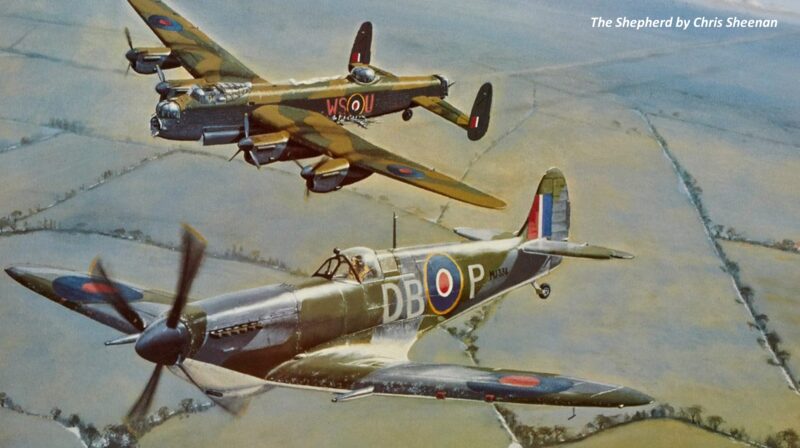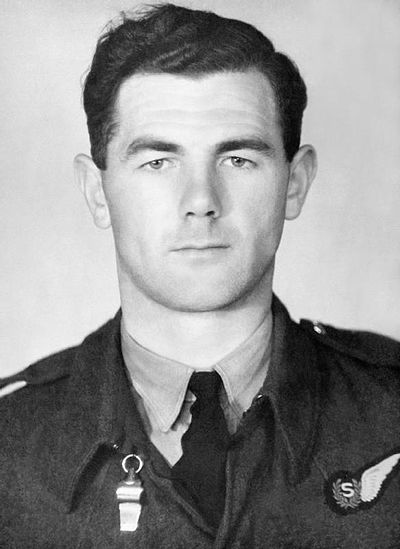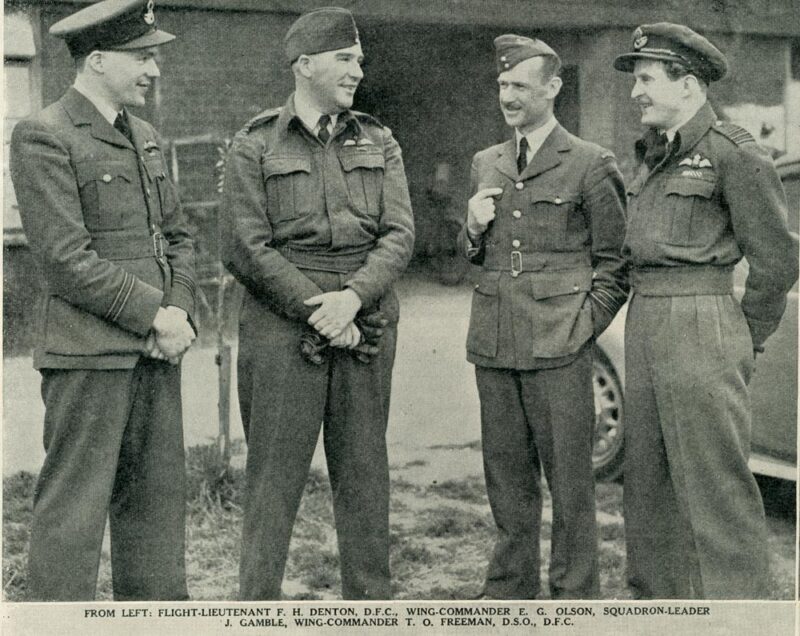Stories
Stories
George Thompson VC and his pilot Harry Denton
Around the walls of the clubroom of the Ellesmere RSA is much memorabilia including a painting by Chris Sheehan. Chris Lay was in attendance years when it was presented to the club by Mrs Denton and was asked to speak to the celebratory 100th year gathering, to explain the story behind the painting. Based on Mrs Denton’s talk plus his own considerable research, Lay tells the remarkable story behind the painting.

“The Shepherd” by Chris Sheehan.
It’s a doomed Lancaster – it’s on fire – two inboard engines feathered – a smashed cockpit canopy, a destroyed rear gunners’ turret and shattered bomb aimers blister on the front of the aircraft. In addition, there is a six-foot hole in the fuselage and the bomb doors are partially open and can’t be shut. The aircraft is struggling to stay in the air, made more difficult with flight controls that can’t be trimmed. Communication with other aircraft or ground control is nil and all the while the struggling pilot is hoping to find somewhere to force-land and save the lives of the crew of seven.
Five Canadian Spitfires, one of which is in the painting, are providing air cover protection for the stricken Lancaster and, despite not being able to communicate by radio, were trying to escort the bomber, firstly to a nearby airfield or alternatively, to find a spot on which to make a forced landing.
It was New Years Day 1945. The Lancaster had successfully dropped 12 x 1000 lb. bombs on the Dortmund-Ems Canal, on a daylight raid, when struck by Anti-Aircraft flak. In its badly damaged state, and losing altitude rapidly, the strength and skill of the Lancaster pilot managed to keep the aircraft in the air for 40 dramatic minutes, which fortunately was sufficient time to return the relative safety of Dutch air space.
The Kiwi pilot F/O Harry Denton spotted a field into which he thought he could belly land his ailing aircraft. With the Lancaster now on approach, the Spitfire, depicted in the picture, suddenly swerved in front of the crippled Lancaster and the Spitfire pilot, without regard for his own safety diverted F/O Denton away from the previously undetected high tension power lines, which, had he hit – would certainly have been fatal for everyone on board.
WHY IS THIS PICTURE SO IMPORTANT?
- The young Lancaster pilot Harry Denton was a Canterbury boy from
- Secondly – The painting was presented to the Ellesmere RSA by Denton, wife of the then late Harry Denton.
- There is more to the story than is depicted in the picture and deserves to be
After the aircraft was hit by flak and reduced to a devastating state of airworthiness – F/O Denton had his own problems to attend to. With the intercom also destroyed, he had no Idea what was going on in the rest of the aircraft or any real knowledge of the exact state of his flying machine.
In the bowels of the aircraft – wireless operator Flight Sergeant George Thompson was battling a raging fire and a 140-knot wind whistling through the hollow aircraft like a blow torch. He extricated the mid-upper gunner from his turret and extinguished his burning clothes with his bare hands, then, with those hands, now burnt down to bare flesh. and other parts of his body severely burnt, he fought his way back to the tail gunner and dragged him past the gaping six-foot hole in the fuselage to a more secure spot amidships, all the time using those same burnt hands to extinguish his mates’ flaming clothes and body.

Fl Sgt George Thompson VC
(Credit: Imperial War Museum)
Following the crash landing, which was physically impossible to do perfectly, the aircraft bounced ten feet into the air, broke in two and tore off two engines. All the crew escaped or ended up scattered on the ground around the wreck. Apart from frostbite, Harry Denton, perhaps the least injured, searched for his mates. Flight Sergeant Thompson with his clothing burnt off, his face blackened and his hands looking like a cooked roast, was unrecognisable until he spoke. He said, “Good Landing Skip”.
The mid-upper gunner died the next day. Fit. Sergeant Thompson died three weeks later. For his bravery he was posthumously awarded the Victoria Cross. His citation read: “His courage has seldom been equaled and never surpassed”.
The remaining four crew suffered severe to minor Injuries, the most serious of which was the tail gunner who had his ears burnt off.
F/O Denton was awarded the DFC for his excellent handling of a distressed aircraft.

Flight Lieutenant Frederick Harry Denton (L) with Wing Commander Edward George Olson, Squadron Leader John Mathias Gamble and Wing Commander Trevor Owen Freeman.
(Credit: Auckland Weekly News, 1 July 1942. Auckland Libraries Heritage Collections).
After the war Harry Denton on returned to New Zealand and farmed in North Canterbury.
THERE IS A COROLLARY TO THIS STORY:
During the presentation of the picture to the Ellesmere RSA Mrs. Denton related a story which I will retell from memory. (That means that some of the minor detail a may be omitted or slightly wrong, but the essence or the story will be accurate):
Apparently 30-40 years after the incident (that puts it in the 70s or 80s) Mr Denton received a phone call. The caller had a foreign accent and asked Harry Denton if he was the pilot of the Lancaster WS-U that dropped bombs on the Dortmund Canal on New Year’s Day 1945. A suspicious Harry reluctantly confirmed that it was him. The voice became excited explaining that after many years of research. He was thrilled to have managed to track him down. He went on to say that he was one of the German anti-aircraft gun crew that had shot him down.
The German went on to explain that at the time they were school children doing what they were told. When the sirens went it was their role to drop everything and, despite their age, man the guns in the school grounds and start firing into the air. They had never hit anything before and from their perspective, it was more by good luck than good management that they had struck Harry Denton’s Lancaster. Furthermore – a group of them were coming to New Zealand and would love to meet him.
With the trauma of that incident flashing back into mind, Harry was understandably shocked and reluctant to oblige but eventually, oblige he did and so, believe it or not, began a remarkable friendship that became lifelong.
– Thanks to the Canterbury Brevet Club, Mrs Denton and the artist for permission to reproduce this article.